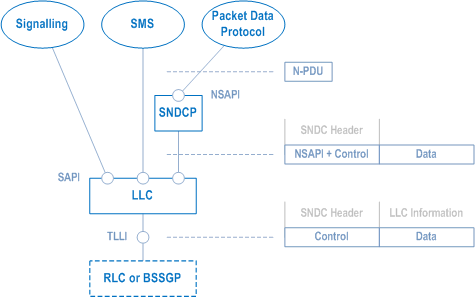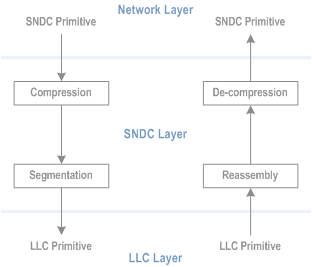Content for TS 23.060 Word version: 18.0.0
1…
5…
5.3.8…
5.4…
5.4.2…
5.4.9…
5.6…
5.6.2
5.6.3…
5.6.3.7…
5.7…
6…
6.3…
6.5…
6.6…
6.8…
6.9…
6.9.1.3
6.9.2…
6.9.2.2…
6.9.2.2.2
6.9.2.2.3…
6.9.2.2.5…
6.9.3…
6.10…
6.12…
6.13…
6.13.1.2…
6.13.2…
6.13.2.2
6.14…
8…
8.2
9…
9.2.2…
9.2.2.2
9.2.2.3…
9.2.3…
9.2.3.2…
9.2.3.3…
9.2.4…
9.2.4.2…
9.2.5…
12…
12.5…
12.6…
12.7…
12.8…
13…
14…
15…
15.3…
16…
16.2…
A…
B…
12 Transmission
12.1 Transmission Modes
12.2 Logical Link Control Functionality (A/Gb mode)
12.3 Subnetwork Dependent Convergence Functionality (A/Gb mode)
12.4 PDCP (Iu mode)
...
...
12 Transmission p. 285
12.1 Transmission Modes p. 285
In A/Gb mode, the LLC and RLC protocols offer various transmission modes. The combinations of the LLC and RLC transmission modes define the QoS attributes SDU error ratio and residual bit error ratio.
In Iu mode, the RLC protocol provides various transmission modes to support user data transmission with different QoS.
The RLC protocol for A/Gb mode and the RLC protocol for Iu mode are distinct protocols.
12.1.1 GTP-U Transmission Modes p. 286
One mode of operation of the GTP-U layer is supported for information transfer between the GGSN and SGSN, unacknowledged (UDP/IP). This is also used between SGSN and S-GW, between S-GW and P-GW, and between RNC and S-GW. In Iu mode, GTP-U is also used on the Iu interface for user data transport. Only the unacknowledged mode (UDP/IP) is supported on the Iu interface.
12.1.2 LLC Transmission Modes (A/Gb mode) p. 286
Two modes of operation of the LLC layer are defined for information transfer; unacknowledged and acknowledged. The LLC layer shall support both modes simultaneously.
- In acknowledged mode, the receipt of LL PDUs is confirmed. The LLC layer retransmits LL PDUs if confirmation has not been received within a timeout period.
- In unacknowledged mode, there is no confirmation required for LL PDUs.
- transport of "protected" information, such that errors within the LLC information field result in the frame being discarded; and
- transport of "unprotected" information, such that errors within the LLC information field do not result in the frame being discarded.
12.1.3 RLC Transmission Modes p. 286
12.2 Logical Link Control Functionality (A/Gb mode) p. 286
The Logical Link Control (LLC) protocol provides a reliable logical link between the MS and its SGSN. As shown in clause "User and Control Planes", the LLC layer is situated below the SNDC layer.
12.2.1 Addressing p. 286
TLLI is used for addressing at the LLC layer. TLLI is described in clause "NSAPI and TLLI for A/Gb mode".
12.2.2 Services p. 286
LLC provides the services necessary to maintain a ciphered data link between an MS and an SGSN. The LLC layer does not support direct communication between two MSs.
The LLC connection is maintained as the MS moves between cells served by the same SGSN. When the MS moves to a cell being served by a different SGSN, the existing connection is released and a new logical connection is established with the new SGSN.
LLC shall be independent of the underlying radio interface protocols. In order to allow LLC to operate with a variety of different radio interface protocols, and to ensure optimum performance, it may be necessary to adjust e.g. the maximum LLC PDU length and the LLC protocol timer values. Such adjustments can be made through negotiation between the MS and the SGSN. The maximum length of an LLC PDU shall not be greater than 1 600 octets minus the BSSGP protocol control information.
12.2.3 Functions p. 287
The Logical Link Control layer supports:
- service primitives allowing the transfer of SNDCP Protocol Data Units (SN PDUs) between the Subnetwork Dependent Convergence layer and the Logical Link Control layer;
-
procedures for transferring LL PDUs between the MS and SGSN, including:
- procedures for unacknowledged delivery of LL PDUs between the MS and the SGSN; and
- procedures for acknowledged, reliable delivery of LL PDUs between the MS and SGSN;
- procedures for detecting and recovering from lost or corrupted LL PDUs;
- procedures for flow control of LL PDUs between the MS and the SGSN; and
- procedures for ciphering of LL PDUs. The procedures are applicable to both unacknowledged and acknowledged LL PDU delivery.
12.3 Subnetwork Dependent Convergence Functionality (A/Gb mode) p. 287
The Subnetwork Dependent Convergence (SNDC) protocol is situated below the network layer and above the Logical Link Control layer in the MS and the SGSN, as shown in clause "User and Control Planes". A variety of network layers are supported; e.g. IP. The network-layer packet data protocols share the same SNDCP, which performs multiplexing of data coming from the different sources to be sent across the LLC. This is illustrated in Figure 80.

The following identities and control information is needed:
- NSAPI identifies the network layer. The SNDCP control part contains compression information.
- TLLI identifies the MS. The LLC control part contains the rest of the LLC protocol header including ciphering information.
12.3.1 Services p. 288
The SNDC function provides the following services to the network layer:
- Transmission and reception of N PDUs in acknowledged and unacknowledged LLC mode. In acknowledged mode, the receipt of data shall be confirmed at the LLC layer, and the data shall be transmitted and received in order per NSAPI. In unacknowledged mode, the receipt of data shall not be confirmed at the SNDCP layer nor at the LLC layer.
- Transmission and reception between the MS and SGSN of variable-length N PDUs.
- Transmission and reception of N PDUs between the SGSN and MS according to the negotiated QoS profile.
- Transfer of the minimum amount of data possible between the SGSN and MS through compression techniques.
- Acknowledged and unacknowledged data transfer.
- Ciphered transmission of SN PDUs.
- In-order delivery of SN PDUs per LLC SAPI.
- Support for variable-length SN PDUs.
12.3.2 Subfunctions p. 288

SNDCP performs the following subfunctions:
- Mapping of SNDC primitives received from the network layer into corresponding LLC primitives to be passed to the LLC layer, and vice versa.
- Multiplexing of N PDUs from one or several NSAPIs onto one LLC SAPI. NSAPIs that are multiplexed onto the same SAPI shall use the same radio priority level, and traffic class. In case BSS packet flow contexts are created all NSAPIs that are multiplexed onto the same LLC SAPI shall share the same BSS packet flow context.
- Compression of redundant protocol control information and user data. This may include e.g. TCP/IP header compression and V.42 bis [32] data compression. Compression may be performed independently for each QoS traffic handling priority and traffic class. If several network layers use the same QoS traffic handling priority and traffic class, one common compressor may be used for these network layers. The relationship between NSAPIs, compressors, and SAPIs is defined in TS 44.065. Compression parameters are negotiated between the MS and the SGSN. Compression is an optional SNDC function. The GGSN may indicate to the SGSN during PDP Context Activation and during Update PDP Context to negotiate no data compression for the PDP context.
- Segmentation and reassembly. The output of the compression subfunctions are segmented to maximum-length LLC frames.
12.4 PDCP (Iu mode) p. 289
The Packet Data Compatibility Protocol (PDCP) transmission functionality maps network-level characteristics onto the characteristics of the underlying network. PDCP can support several network layer protocols by providing protocol transparency for the users of the service. PDCP provides protocol control information compression. PDCP is located in the MS and the RAN and is described in TS 25.323.